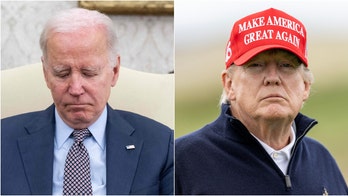COVID-19 sparks debate over whether Congress should be able to vote remotely
The House Rules Committee releases a new report on the pros and cons of a remote voting system; Chad Pergram reports.
The coronavirus pandemic has claimed an unlikely victim on Capitol Hill: the custom of the roll call vote.
Both the House and Senate this week formally delayed any semblance of regular sessions until at least May 4. Likely later. Congress could always try to pass legislation with a limited crew on hand in an emergency. But social distancing doesn’t lend itself to ushering several hundred people into the same room at the same time while the House and Senate vote. It’s doubtful there will be any regular roll call votes in Congress any time soon.
But let’s explore another casualty of coronavirus, associated with voting on Capitol Hill.
CORONAVIRUS: WHAT YOU NEED TO KNOW
Fifteen minutes. That’s how long a standard, electronic roll call vote is supposed to run in the House of Representatives. Fifteen minutes for a vote in the U.S. Senate, too. Although, it should be noted that the Senate lacks an electronic voting system. Senators enter the chamber and signal manually with their hands whether they support or oppose an issue.
But in reality, it’s rare that any vote scheduled for 15 minutes in either body truly runs 15 minutes. More like 25 minutes in the House. Votes sometimes stretch a little longer in the Senate, even though that boasts 335 fewer members than the House.
Part of the reason the votes run long is that Congress is the perfect microcosm of society. There are members who are punctual. To some, showing up ten minutes ahead of time is running late. And then, you’re always going to have stragglers. People who just can’t seem to get it together to get anywhere on time. Ever. Let alone to vote on the floor of the House or Senate.
“One more! One more! One more!” you hear outside the House chamber as a member bounds up the steps and sprints into the chamber, like a sixth grader chasing the school bus.
“One more! One more! One more!” bellows another member as they pour out of a nearby elevator and cut through the Speaker’s Lobby. They wave their voting card like it’s the winning lottery ticket.
As we say, you try to get 435 or 100 people in the same room at the same time. Saltwater taffy sold on the boardwalk at Ocean City doesn’t stretch like a roll call vote on Capitol Hill.
The late Rep. Steven LaTourette, R-Ohio, often presided over the House chamber during big votes. At a 2007 hearing probing House voting practices, the Ohio Republican presciently observed the following: “The same people who were late to votes 15 years ago are the same ones late today.”
‘Nuff said.
Roll call votes are about the two most important things on Capitol Hill. When it comes to a vote itself, Congress distills the quintessence of challenging, global policy issues into an unvarnished, binary choice. Yes or no. Yea or nay. Either, or. There is no Congressional covenant which says lawmakers get to offer amendments to bills. There’s no promise their pet legislation will make it into law. No pledge that members even earn a committee assignment. The only thing guaranteed in Congress is the right of members to cast ballots on the House and Senate floors.
But there’s another important reason the House and Senate often elongate votes. And, it has nothing to do with tardiness. There’s a camouflaged, less obvious purpose.
Congress is a gigantic, complicated place. 541 total members, including the six non-voting delegates to the House. Thousands of aides. Hundreds of reporters. Several thousand lobbyists. The members flitter around the Capitol complex all day long, quadruple-booked. They dash from hearings to the floor for a vote, to the Senate steps for a picture with a school group, then run into the Senate dining room for a ham sandwich. A little later, they book it to the Russell Rotunda for a live TV hit. It never stops. The members don’t have a lot of time to get to know one another. To chat. To talk. To understand what makes each other tick.
The same goes for Congressional leaders. They need time to talk with members to see what problems they may have with legislation. Is there an issue in committee which needs special attention? Maybe the member needs some help campaigning back home because they’re busy tending to personal matter.
The House and Senate floors are part social club, therapy session, locker room and legislative crucible. It’s one of the few places where members have face-to-face conversations with one another from both sides. This is where the gears of government churn, making things happen. Watch lawmakers congregate near the rear of a chamber or in the well during a vote. It’s negotiation. Give and take. Finding consensus. Understanding what the other side is up to. The floor is where members go to get things done. Gain support for their amendment. See if someone from the Great Plains will co-sponsor your bill. Join in signing your letter to the HUD Secretary. See if that member from the Northeast will even join you for a round of golf so you can discuss things over a beer on the 19th hole.
The leadership sometimes holds a vote open so they can deploy their whip teams to find members on the floor and get a good vote count on an upcoming bill. Sometimes the leadership deliberately adds a procedural vote or two in a vote sequence so they can spend more time talking to members to understand their concerns about legislation or make sure that vote count is ironclad.
There is no substitution for face-to-face contact between members. Certainly lawmakers can accomplish a lot on telephone calls and sometimes, via video conference. But a heart-to-heart in the Majority Leader’s Office or a serious chat in the cloakroom, ear-to-ear, is what greases the machinery on Capitol Hill.
As one former member confided to Fox, it’s essential that lawmakers be around one another to pick up non-verbal cues and nuance. You can’t trade 231 years of Congressional DNA for Zoom.
Fox was told in early March, the phase two coronavirus bill kept hitting problems because it was hard to get all of the parties in the same room to negotiate. Then, Congress finally pulled together the $2.2 trillion phase three bill. You want to spend a couple more trillion without lugging everyone into the same room again? Do lawmakers and aides even want to be in the same room anytime soon to negotiate that legislation? Is it even safe to do so? Granted, Congressional leaders and the White House weren’t negotiating these deals on the House and Senate floors. But it underscores the point that it’s just a lot harder to conduct the nation’s business on Skype.
This is simple. Which is more fulfilling? Would you rather gossip with your best friend, glass in hand, at a cozy wine bar? Or, snuggle up on the couch, wine glass in hand on a Friday night for a Zoom happy hour? That’s to say nothing of the security concerns. A Zoom “hacking” hour?
The House and Senate floors are transactional places. A roll call vote may be the purpose that draws members to the floor. But it’s what unfolds around the vote which is often more important than the vote itself. And that’s why it’s now a struggle to get things done on Capitol Hill.







